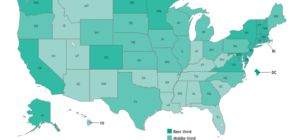

New State Grades on the Economic Status of Women Show Stagnant or Declining Progress in Most States
FOR IMMEDIATE RELEASE
March 28, 2018
Contact: Jennifer Clark | 202-785-5100 | clark@iwpr.org
District of Columbia, Maryland, and Massachusetts receive top grades, while Mississippi ranks last
Washington, DC—The Institute for Women’s Policy Research (IWPR) released new grades for each state on two composite indices related to women’s economic status, the Status of Women in the States Employment & Earnings Index and the Poverty & Opportunity Index. Since 2015, the last time state scores were calculated, most state grades remained the same, indicating stagnating progress on each index. Eleven states received a lower grade on the Employment & Earnings Index, while 16 states received a lower grade on the Poverty & Opportunity Index.
The District of Columbia, Maryland, and Massachusetts once again hold the top three places on the Employment & Earnings Index. South Dakota saw the greatest improvement in letter grades among the states, earning a C+ in 2018, up from a D in 2015. Mississippi, West Virginia, and Idaho are the worst states for women on the Employment & Earnings Index, all receiving the lowest grade, F.
Although Maryland, the District of Columbia, and Massachusetts also received the top grades on the Poverty & Opportunity Index in 2018, each of those states earned a B, a lower grade than in 2015, when the District of Columbia received an A- and Maryland and Massachusetts each received a B+. Mississippi is the only state to receive an F on the Poverty & Opportunity Index, with Louisiana, Kentucky, West Virginia, and Arkansas each receiving a D-.
IWPR President Heidi Hartmann, Ph.D. commented on the findings:
“Some states have seen marked improvement in the economic status of women over the last few years. But with the economy finally thriving after the Great Recession and long recovery, women in most states have seen little progress on their economic status and some are seeing their status decline. If states really want to see their economies flourish, they will invest in improving the economic status of women, especially women of color, who tend to fare worse in all states.”
The best and worst states on key indicators of the economic status of women in the states include:
Employment & Earnings
- Women’s Earnings: Women working full-time, year-round have the highest earnings in the District of Columbia, where women’s median annual earnings are $65,000, more than double women’s earnings in the worst state, Mississippi ($31,300).
- Gender Wage Gap: Women in California earn 90 percent of what men in the state earn, while women in Louisiana earn just 69 percent of what men earn.
- Women’s Labor Force Participation: District of Columbia has the highest share of women in the labor force (67.4 percent), while West Virginia has the lowest share (50.2 percent).
- Women in Professional/Managerial Occupations: 60.7 percent of employed women in the District of Columbia work in professional or managerial occupations, compared with just 31.7 percent of employed women in Nevada.
Poverty & Opportunity
- Poverty: Women are least likely to live in poverty in New Hampshire—where nearly 90 percent of women in the state live above the poverty line—and most likely in the District of Columbia, where only 73.3 percent of women live above the poverty line.
- Health Insurance Coverage: More nonelderly women have health insurance in Massachusetts (97.5 percent), the state with the highest rate of coverage, than in Texas, the state with the lowest rate, where 78.1 percent of women have coverage. Between 2015 and 2018, every state saw an increase in the percentage of women with health insurance. New Mexico and West Virginia each saw a 15 percentage point increase, the greatest increase among the states in the share of women with health insurance coverage.
- Education: More than half (56.3 percent) of women aged 25 or older in the District of Columbia hold at least a bachelor’s degree, the jurisdiction with the highest share in the country, compared with less than one in four women in West Virginia (21.7 percent), the state with the lowest share.
- Women’s Business Ownership: The share of businesses owned by women is highest in the District of Columbia, where women own 43 percent of businesses, and lowest in South Dakota where women own 29 percent. Georgia has the second highest share of businesses owned by women at 41 percent.
IWPR also released 51 state fact sheets that include additional data for each state on differences among women by race/ethnicity, the year when women are projected to reach equal pay in the state, and the impact that equalizing pay would have on each state’s poverty reduction and economic growth.
To download a fact sheet for your state, visit IWPR’s interactive Status of Women in the States website at statusofwomendata.org.
The Institute for Women’s Policy Research (IWPR) is a 501(c)(3) tax-exempt organization that conducts and communicates research to inspire public dialogue, shape policy, and improve the lives and opportunities of women of diverse backgrounds, circumstances, and experiences. IWPR also works in affiliation with the Program on Gender Analysis in Economics at American University.
-END-